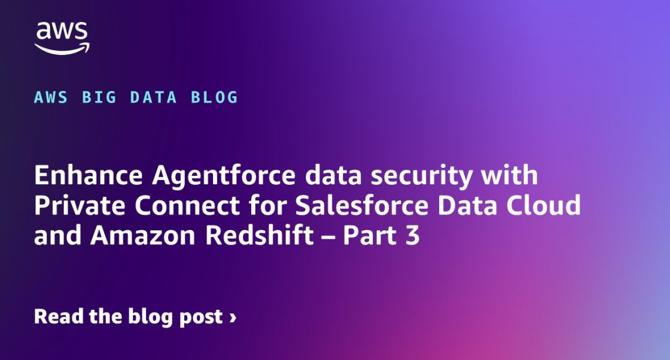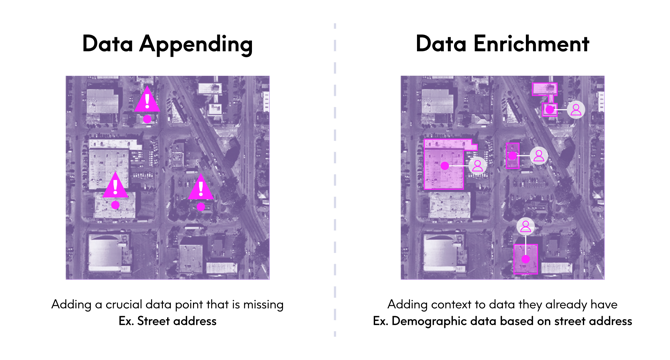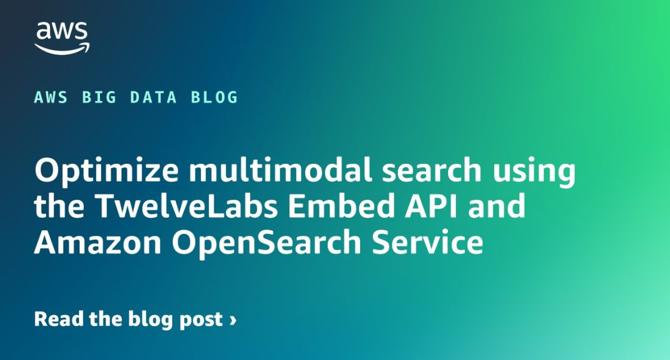Big Data News
Siliconangle
155

Image Credit: Siliconangle
Exclusive: Data mesh creator brings first product to market
- Nextdata Technologies Inc. is introducing Nextdata OS, a unified data product development and operating platform.
- Nextdata OS encapsulates data products in software containers to ensure consistency across different computing environments.
- The self-service features of Nextdata OS allow decentralized domain teams to build, share, and discover autonomous data products.
- NextData is providing generative AI assistants to help developers build data products from existing assets, reducing the process from months to hours.
Read Full Article
9 Likes
Amazon
92

Image Credit: Amazon
Enhance Agentforce data security with Private Connect for Salesforce Data Cloud and Amazon Redshift – Part 3
- Salesforce Private Connect with AWS PrivateLink enhances data security by eliminating common security risks associated with public endpoints, working with Salesforce Data Cloud to keep customer data secure.
- The solution involves configuring PrivateLink for an Amazon Redshift instance to establish private connectivity from Salesforce Data Cloud for enhanced security.
- Organizations are recommended to use an Amazon Redshift managed VPC endpoint for private access to Redshift clusters or serverless workgroups.
- The process includes creating security groups, target groups, a network load balancer, and managing permissions for Amazon Redshift instances.
- Automating IP address management is crucial for failover scenarios in Amazon Redshift provisioned in different deployment modes, ensuring consistent private connectivity.
- Various failover scenarios are discussed for Amazon Redshift in Single-AZ RA3, Multi-AZ RA3 clusters, and Redshift Serverless deployments, providing insights on handling connectivity changes.
- The article highlights how to automate NLB network target updates, monitor DNS resolution, use Lambda functions for reconciliation, and trigger events based on cluster operations.
- Authors include experts from AWS and Salesforce, sharing insights on securing data connections between Salesforce Data Cloud and Amazon Redshift using PrivateLink.
- Yogesh Dhimate, Avijit Goswami, Ife Stewart, Mike Patterson, and Drew Loika are among the authors, bringing diverse expertise in cloud computing, data analytics, customer solutions, and product management.
- The post emphasizes the importance of using AWS endpoint services for enhancing data security and encourages implementing the provided steps for a secure network connection between Salesforce and AWS.
- For detailed information on enhancing data security with Private Connect for Salesforce Data Cloud and Amazon Redshift, readers are encouraged to refer to this comprehensive guide.
Read Full Article
5 Likes
Precisely
178

Image Credit: Precisely
Data Appending vs. Data Enrichment: How to Maximize Data Quality and Insights
- The terms 'data appending' and 'data enrichment' are often used interchangeably, although they serve slightly different purposes in enhancing existing datasets with new information.
- Data appending involves filling in missing data in existing records, while data enrichment adds contextual information to deepen insights and understanding.
- Appending is useful for adding crucial missing data points, whereas enrichment helps in achieving targeted marketing, personalized recommendations, and improved customer experience.
- To choose between appending and enrichment, consider if you need to fill in missing data points (appending) or if you want to enhance existing records with richer insights (enrichment).
- Challenges in ensuring data quality through appending and enrichment include issues with data fit, matching accuracy, data inconsistencies, data changes, lack of documentation, and data decay.
- To maximize the impact of appended and enriched data, understanding data sources, timing of updates, transformations, and data validation is crucial.
- Utilizing unique and persistent record identifiers can streamline data enrichment and appending processes and enhance data quality.
- Precisely offers data enrichment solutions focusing on data quality, advanced matching, seamless data integration, and tailored expertise to drive better business outcomes and achieve higher ROI.
- By maintaining data quality, planning for ongoing maintenance, and leveraging tools such as record IDs and Precisely solutions, businesses can unlock the full potential of their data.
- Data enrichment and data appending both deliver significant value, emphasizing the importance of data quality in driving better decisions and operational efficiency.
- Understanding the nuances, challenges, and leveraging tools like record IDs is essential for businesses looking to maximize data quality and insights.
Read Full Article
10 Likes
Dzone
238

Image Credit: Dzone
Building a Cost-Effective ELK Stack for Centralized Logging
- Implementing ELK (Elasticsearch, Logstash, Kibana) stack on cloud platforms like GCP using Terraform and Ansible offers cost-effective centralized logging solutions.
- ELK stack components include Elasticsearch for storing and indexing data, Logstash for filtering logs, and Kibana for visualization.
- The infrastructure setup involves master nodes, data nodes, Kibana nodes, and Logstash nodes for scalability and fault tolerance.
- Terraform is used to create the infrastructure with files like create_elk_instances.tf and variables.tf, allowing easy provisioning of VM instances.
- Permissions are assigned to service accounts, and GCP buckets are created for certificates and backups.
- Ansible is then used to configure ELK stack components like Elasticsearch, Kibana, and Logstash on Debian, automating the installation and setup process.
- Configuration files for Ansible like elasticsearch_master.j2, elasticsearch_node.j2, kibana.j2, and logstash.j2 are provided to define settings for each node type.
- Filebeat configuration is also included for shipping logs directly from applications and setting up index patterns for data organization.
- By using ELK stack with Terraform and Ansible automation, companies can achieve centralized logging efficiently, reducing licensing costs and ensuring scalability.
- The setup allows for easy monitoring, log visualization, and alerting using Kibana's user-friendly interface, enhancing operational efficiency.
- The article concludes with a note on cost-effectiveness, ease of scaling, and the benefits of leveraging open-source ELK stack for effective centralized logging.
Read Full Article
14 Likes
Amazon
54

Image Credit: Amazon
Optimize multimodal search using the TwelveLabs Embed API and Amazon OpenSearch Service
- The integration of TwelveLabs Embed API and Amazon OpenSearch Service offers advanced video search and analysis capabilities, allowing users to search, analyze, and extract insights from vast video libraries efficiently.
- By combining TwelveLabs' AI-powered video understanding technology with OpenSearch's search and analytics capabilities, advanced video discovery and deeper insights can be achieved.
- With TwelveLabs' multimodal embeddings capturing visual, audio, and textual signals, precise context-aware video search is enabled, benefiting developers and businesses in enhancing their applications and content management strategies.
- The TwelveLabs Embed API provides features like multimodal understanding, temporal coherence, flexibility, and high performance, offering developers and businesses enhanced search capabilities, content recommendation, scene detection, and content moderation.
- Key components of the architecture include the TwelveLabs Embed API for generating video embeddings, OpenSearch Vector Database for storing the embeddings, and integration with Secrets Manager for managing API access keys and OpenSearch credentials.
- Use cases of the Embed API include anomaly detection, diversity sorting, sentiment analysis, and recommendations, enabling organizations to efficiently analyze and extract value from their video data.
- The process involves setting up the TwelveLabs SDK, generating video embeddings, ingesting these embeddings into an OpenSearch index, and performing vector searches for text-to-video, audio-to-video, and image-to-video queries.
- Developers can follow detailed instructions in a GitHub repository to implement advanced video search capabilities, including generating embeddings, creating an index in OpenSearch, ingesting embeddings, and conducting vector searches for various search types.
- The benefits include facilitating rapid and efficient content retrieval, reducing search time, enhancing content recommendation systems, and enabling nuanced video content analysis for diverse industries.
- The integration empowers businesses to unlock hidden insights, improve user experiences, and make data-driven decisions based on comprehensive video analysis, positioning them for future innovations in video data utilization.
- This advanced solution addresses current challenges in video content management and opens up opportunities for new ways to interact with video content, making it indispensable for industries relying on video for various purposes.
Read Full Article
3 Likes
TechBullion
293

Image Credit: TechBullion
US-based Nigerian Rahmat Raji is Designing for Impact and Inclusivity in Technology
- Rahmat Raji, a US-based Nigerian Senior Product Designer at Ozette Technologies Inc., specializes in creating socially impactful products that align with business objectives.
- Rahmat's design work in improving the accessibility of communication tools for children with autism achieved significant results, including an 85% reduction in communication errors and improved task completion rates for participants with motor deficits.
- Accessibility and inclusivity are at the heart of Rahmat's design philosophy, as she aims to contribute to tackling complex problems and enabling people to live, work, or interact better.
- Rahmat's work at Ozette Technologies Inc. exemplifies her commitment to human-centered design and pushing the boundaries of inclusive design and accessibility in the technology industry.
Read Full Article
17 Likes
Amazon
9

Image Credit: Amazon
Correlate telemetry data with Amazon OpenSearch Service and Amazon Managed Grafana
- Troubleshooting complex enterprise applications involves challenges like tracing requests, identifying bottlenecks, and understanding cascading failures.
- Correlating signals like logs, traces, and metrics can provide insights into root causes of problems and reduce Mean Time to Resolution.
- Amazon OpenSearch Service and Managed Grafana offer solutions to analyze and visualize telemetry data at scale.
- Architecture involves microservices on Amazon EKS emitting telemetry data to the OpenTelemetry Collector for uniform collection.
- Separating observability signal data into OpenSearch Ingestion pipelines facilitates scalability and fault isolation.
- Prerequisites include configuring Amazon Managed Prometheus workspace, OpenSearch Service domains, and Grafana workspace.
- Setting up IAM policies, roles, and ingestion pipelines enables efficient data processing in OpenSearch Service.
- Deploying an OpenTelemetry demo application on EKS allows for monitoring telemetry data with Grafana and OpenSearch Service.
- Configuring the OpenTelemetry Collector for logs, traces, and metrics export to respective targets enhances data visualization and analysis.
- Creating correlations in Amazon Managed Grafana links logs, traces, and metrics for seamless analysis and insight extraction.
Read Full Article
Like
Precisely
453

Image Credit: Precisely
5 Best Practices for Digital Archiving
- Having a strong digital archiving strategy is essential for organizations managing digital content.
- Align archiving strategy with business goals, compliance requirements, and customer experience.
- Centralize storage and capture customer data from multiple channels for better compliance and efficiency.
- Leverage automation, prioritize security and data integrity, and enable easy access for improved archiving.
Read Full Article
27 Likes
Precisely
137

Image Credit: Precisely
Precisely Women in Technology: Meet Sarah
- The Precisely Women in Technology (PWIT) network at Precisely supports women in tech by providing a platform to connect, share experiences, and learn from each other.
- Sarah Warren, a Principal Solutions Engineer, shares her experience working in technology for the last seven years and explains how she unintentionally fell into the field.
- Sarah highlights her mentor, Kristin Aldridge, for providing consistency and female mentorship, helping her grow in her career by encouraging ownership and prioritizing people.
- Taking a big risk by transitioning from a mathematical background to a technical role, Sarah found the challenge of constant growth and the supportive community at Precisely rewarding.
- Sarah discusses challenges faced by women in tech, such as lack of confidence, and shares how she overcomes them by taking on speaking opportunities outside her comfort zone.
- The best advice Sarah received was to be receptive to feedback, enabling personal and professional growth, emphasizing the importance of concise communication in both settings.
- Encouraging younger women to be themselves and bring their unique perspectives to the industry, Sarah advises breaking out of expected norms and embracing individuality in problem-solving.
- As a successful woman in technology, Sarah pays it forward by serving as the Guest Speaker Committee Co-chair for PWIT at Precisely and supporting young girls to build skills and engage in tech projects.
- The Precisely Women in Technology network provides a space for women to share career journeys, gain new perspectives, and make connections, aiming to empower and advocate for women in tech.
- Sarah's journey exemplifies the importance of mentorship, risk-taking, and self-confidence in navigating a career in technology, while also highlighting the value of community and advocating for gender diversity.
- By sharing her experiences and advice, Sarah inspires and uplifts other women in the industry, emphasizing the significance of individual growth, unique perspectives, and supportive networks in driving change and innovation.
Read Full Article
8 Likes
Siliconangle
169

Image Credit: Siliconangle
Exclusive: Panzura unlocks metadata from IBM Deep Archive files for AI training
- Panzura, maker of a hybrid cloud data management platform, integrates its Symphony data services platform with IBM's Storage Deep Archive.
- Integration with IBM's Diamondback tape library enables easy access to 'cold' data stored on tape for information discovery and AI training.
- Symphony's metadata discovery features unlock information that would otherwise be inaccessible without human inspection and tagging.
- The combination of Panzura's Symphony and IBM's Deep Archive is expected to be useful in training AI models that require vast amounts of data.
Read Full Article
10 Likes
TechBullion
440

Image Credit: TechBullion
Felix Roemer – A Strategic Mind in Data-Driven Entrepreneurship and Investment
- Felix Roemer, known for data-driven entrepreneurship and investment, began with in-game trading platforms before transitioning to real-world investments.
- His early interest in virtual economies, particularly in online games like RuneScape, honed his market analysis skills and understanding of economic principles.
- Roemer's success in in-game trading laid the foundation for his proficient data analytics and data-driven decision-making in investments.
- Transitioning to professional investing, Roemer utilized his analytical skills to identify market inefficiencies and drive growth through data insights.
- His objective approach to sports analytics, focusing on soccer, emphasized data over emotional bias, providing a unique perspective on the field.
- Roemer's career ethos revolves around data-driven processes that prioritize sustainable growth and operational optimization for long-term success.
- His involvement in Short Circuit Science showcased his ability to merge technology with traditional industries for improved performance using AI and computer vision.
- Roemer's commitment to ethical entrepreneurship is underscored by his integrity, independence, and focus on positive impacts through business endeavors.
- Through his strategic precision and application of data in investing, Roemer has successfully transformed distressed assets into profitable ventures.
- Felix Roemer emphasizes maintaining a work-life balance and personal well-being, incorporating practices like meditation and exercise to manage stress.
Read Full Article
26 Likes
Precisely
50

Image Credit: Precisely
Expand Your Business Data and Process Automation Adoption Through Citizen Development
- To increase the adoption of business data and process automation, organizations should understand citizen developers and the differences between no-code, low-code, and pro-code automation.
- Business process automation (BPA) is crucial for streamlining operations, reducing costs, and improving efficiency, with two popular approaches being no-code and pro-code automation.
- No-code automation platforms allow non-technical users to create applications without coding expertise, offering benefits such as lower development costs, faster time to value, efficient resource allocation, and increased agility.
- Pros of no-code automation include ease of use, cost-effectiveness, and speed, while cons include limited customization, performance limitations, and flexibility constraints.
- Pro-code automation offers deep customization and integration capabilities, tailored solutions, end-to-end process automation, and scalability for complex workflows.
- Pros of pro-code automation include high customization, solution complexity, and integration possibilities, while cons include higher development costs, longer development times, and resource constraints.
- Finding the right balance between no-code/low-code and low-code/pro-code automation depends on specific organization requirements and goals, with both approaches contributing to effective automation adoption and scaling.
- Choosing the appropriate automation tool based on needs and strategies is crucial for successful automation implementation and expansion within an organization.
- Both no-code and pro-code automation platforms play essential roles in automation adoption, with each offering unique benefits and drawbacks suited to different business scenarios.
- Ultimately, utilizing both approaches can help organizations effectively scale automation and address complex business process automation needs.
- For organizations exploring automation solutions, reaching out to experts can provide guidance on the best strategies and tools tailored to specific needs.
Read Full Article
3 Likes
Siliconangle
160

Image Credit: Siliconangle
Progress Software pleases investors as it beats expectations and raises its full-year guidance
- Progress Software beats expectations with solid earnings and revenue in the first quarter.
- The company raises its full-year guidance for fiscal 2025.
- Progress Software's net profit for the quarter declines compared to the year-ago period.
- The company's stock gains over 6% in after-hours trading.
Read Full Article
9 Likes
Currentanalysis
246

Image Credit: Currentanalysis
GenAI Startup CoreWeave Goes Public Amid Tumultuous IPO
- CoreWeave’s IPO was the first time an AI startup went public since the beginning of the generative AI (GenAI) boom.
- The IPO market has been very slow against the backdrop of an increasingly volatile geopolitical environment.
- The IPO of CoreWeave, a data center operator renting out computing power to big tech companies, took place with a reduced valuation of $23 billion, down from the initial estimate of $32 billion.
- CoreWeave heavily relies on major customers Microsoft and OpenAI, and its IPO highlights the still controversial nature of GenAI investments.
Read Full Article
14 Likes
Aviationfile
68

Image Credit: Aviationfile
Skywise: How Airbus Is Transforming Aviation Through Big Data
- Skywise is a powerful aviation data platform developed by Airbus, in partnership with Palantir Technologies.
- It is an integrated ecosystem that helps airlines, MRO providers, and OEMs unlock actionable insights from complex aircraft data.
- Skywise aggregates and analyzes data to enable predictive maintenance, fleet performance monitoring, maintenance and engineering optimization, and secure data sharing and collaboration.
- Over 140 airline operators and thousands of aircraft are currently connected to Skywise.
Read Full Article
4 Likes
For uninterrupted reading, download the app